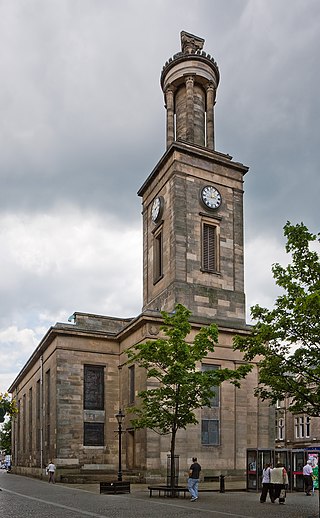
Elgin is a historic town and formerly a royal burgh in Moray, Scotland. It is the administrative and commercial centre for Moray. The town originated to the south of the River Lossie on the higher ground above the floodplain where the town of Birnie is. There, the church of Birnie Kirk was built in 1140 and serves the community to this day.

A Pictish stone is a type of monumental stele, generally carved or incised with symbols or designs. A few have ogham inscriptions. Located in Scotland, mostly north of the Clyde-Forth line and on the Eastern side of the country, these stones are the most visible remaining evidence of the Picts and are thought to date from the 6th to 9th century, a period during which the Picts became Christianized. The earlier stones have no parallels from the rest of the British Isles, but the later forms are variations within a wider Insular tradition of monumental stones such as high crosses. About 350 objects classified as Pictish stones have survived, the earlier examples of which holding by far the greatest number of surviving examples of the mysterious symbols, which have long intrigued scholars.
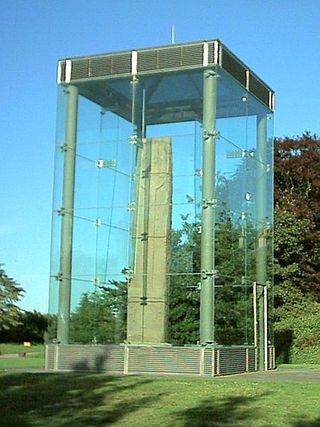
Sueno's Stone is a Picto-Scottish Class III standing stone on the north-easterly edge of Forres in Moray and is the largest surviving Pictish style cross-slab stone of its type in Scotland, standing 6.5 metres in height. It is situated on a raised bank on a now isolated section of the former road to Findhorn. The stone is named after Sweyn Forkbeard, but this association has been challenged and it has also been associated with the killing of King Dubh mac Ailpin in Forres in 966. The stone was erected c. 850–950 but by whom and for what, is unknown.
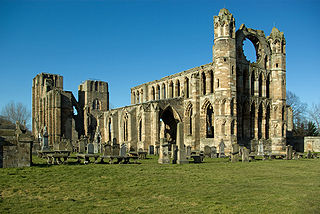
Elgin Cathedral, a historic ruin in Elgin, Moray, northeast Scotland, was dedicated to the Holy Trinity. It was established in 1224 on land granted by King Alexander II and stood outside the burgh of Elgin, close to the River Lossie. It replaced the cathedral at Spynie located 3 kilometres (2 mi) to the north, which was served by a small chapter of eight clerics. By 1226, the new and developing cathedral was staffed with 18 canons, a number that increased to 23 by 1242. A damaging fire in 1270 led to significant enlargement. It remained unscathed during the Wars of Scottish Independence but suffered extensive fire damage in 1390 when attacked by Robert III's brother Alexander Stewart, Earl of Buchan, also known as the Wolf of Badenoch. In 1402, the cathedral precinct faced another incendiary attack by the Lord of the Isles followers.

Spynie Palace, also known as Spynie Castle, was the fortified seat of the Bishops of Moray for about 500 years in Spynie, Moray, Scotland. The founding of the palace dates back to the late 12th century. It is situated about 500 m from the location of the first officially settled Cathedral Church of the Diocese of Moray, Holy Trinity Church in present-day Spynie Churchyard. For most of its occupied history, the castle was not described as a palace — this term first appeared in the Registry of Moray in a writ of 1524.

The Hilton of Cadboll Stone is a Class II Pictish stone discovered at Hilton of Cadboll, on the East coast of the Tarbat Peninsula in Easter Ross, Scotland and now in the National Museum of Scotland. It is one of the most magnificent of all Pictish cross-slabs. Until its felling in a storm in 1674, it faced East - West in a natural amphitheatre about 100m from the shore, which runs NE - SW. Like other similar stones, it can be dated to about AD 800.
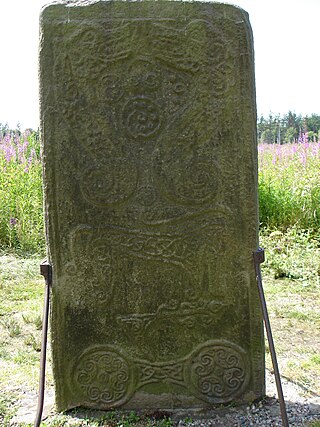
Rodney's Stone is a two-metre high Pictish cross slab now located close on the approach way to Brodie Castle, near Forres, Moray, Scotland. It was originally found nearby in the grounds of the old church of Dyke and Moy. It is classed as a Class II Pictish stone, meaning that it has a cross on one face, and symbols on the other. On the symbols face, at the top, are two fish monsters; below is a "Pictish Beast", and below that a double disc and Z-rod. On the cross face there is a cross and some animals.

Spynie was a seaport, burgh and ancient parish in Moray, Scotland, that survives as a small hamlet and civil parish. It is the location of the ruins of Spynie Palace, which was the principal residence of the Bishops of Moray between the 12th and 17th centuries, and the churchyard of Holy Trinity Church, Spynie, which served as the cathedral of the Diocese of Moray between 1207 and 1224.
The Diocese of Moray was one of the most important of the medieval dioceses of the Roman Catholic Church in Scotland. Its territory was in central northern Scotland.

Scotland was divided into a series of kingdoms in the early Middle Ages, i.e. between the end of Roman authority in southern and central Britain from around 400 AD and the rise of the kingdom of Alba in 900 AD. Of these, the four most important to emerge were the Picts, the Gaels of Dál Riata, the Britons of Alt Clut, and the Anglian kingdom of Bernicia. After the arrival of the Vikings in the late 8th century, Scandinavian rulers and colonies were established on the islands and along parts of the coasts. In the 9th century, the House of Alpin combined the lands of the Scots and Picts to form a single kingdom which constituted the basis of the Kingdom of Scotland.
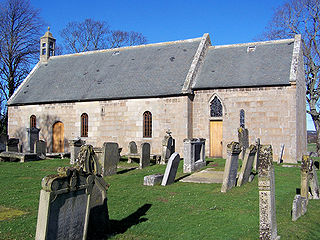
Birnie Kirk is a 12th century parish church located near Elgin, in Moray, Scotland. It was the first cathedral of the Bishop of Moray and is one of the oldest in Scotland to have been in continuous use. The graveyard, symbol stone and archaeological remains under the church have been designated a scheduled monument by Historic Environment Scotland.

Kinneddar is a small settlement on the outskirts of Lossiemouth in Moray, Scotland, near the main entrance to RAF Lossiemouth. Long predating the modern town of Lossiemouth, Kinneddar was a major monastic centre for the Pictish kingdom of Fortriu from the 6th or 7th centuries, and the source of the important collection of Pictish stones called the Drainie Carved Stones. The Kirk of Kinneddar was the cathedral of the Diocese of Moray between 1187 and 1208, and remained an important centre of diocesan administration and residence of the Bishop of Moray through the 13th and 14th centuries.
The Dandaleith stone is a Class I Pictish stone from Craigellachie, Scotland. It was discovered in May 2013 during ploughing.

Burghead Fort was a Pictish promontory fort on the site now occupied by the small town of Burghead in Moray, Scotland. It was one of the earliest power centres of the Picts and was three times the size of any other enclosed site in Early Medieval Scotland. The fort was probably the main centre of the Pictish Kingdom of Fortriu, flourishing with the kingdom itself from the 4th to the 9th centuries.

The Burghead Bulls are a group of carved Pictish stones from the site of Burghead Fort in Moray, Scotland, each featuring an incised image of a bull. Up to 30 were discovered during the demolition of the fort to create the town of Burghead in the 19th century, but most were lost when they were used to build the harbour quayside. Six remain: two in the Visitor Centre in Burghead, two in Elgin Museum, one in the National Museum of Scotland in Edinburgh, and one in the British Museum in London.

Elgin Museum is a museum of local history in Elgin, Moray, Scotland. Its collections cover area fossils and geology, archaeology, ethnography, art and local history. Opened in 1843, it is one of the oldest independent museums in the country. The museum is run by The Moray Society. Entry to the museum is free.

The Sculptor's Cave is a sandstone cave on the south shore of the Moray Firth in Scotland, near the small settlement of Covesea, between Burghead and Lossiemouth in Moray. It is named after the Pictish carvings incised on the walls of the cave near its entrances. There are seven groups of carvings dating from the 6th or 7th century, including fish, crescent and V-rod, pentacle, triple oval, step, rectangle, disc and rectangle, flower, and mirror patterns, some very basic but others more sophisticated.
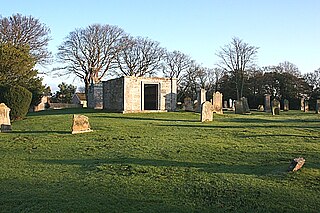
Holy Trinity Church, Spynie was until 1735 the parish church of Spynie, Moray in north-east Scotland, and served as the cathedral of the Diocese of Moray between 1207 and 1224.

St Giles' Church is a Church of Scotland church situated in the centre of Elgin, Moray, in north-east Scotland. It is Elgin's original parish church.

The Birnie Symbol Stone is a class I Pictish stone, now situated on the north side of the graveyard of Birnie Kirk, in Moray, Scotland. It was discovered in c. 1850 within the wall of the graveyard, from where it was moved to its current location.




















